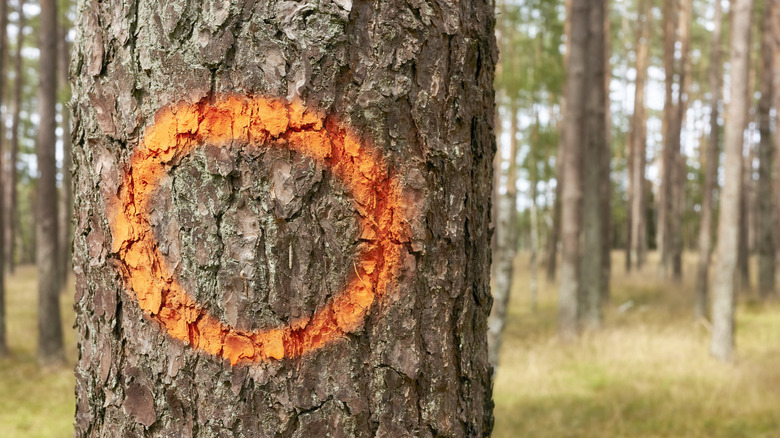If You See Orange Paint On A Tree, This Is What It Means
It's not unusual to spot markings on trees while walking through wooded areas, but one color, in particular, may catch your eye. While the meaning can vary slightly based on region or landowner intent, one explanation holds true for most uses in America: orange paint is a deliberate signal to humans that the given tree has been intentionally identified as part of a management plan, usually indicating it should be left alone.
Orange paint is commonly used to mark trees that should or shouldn't be cut down. The markings help foresters, loggers, and land managers identify trees that must be preserved during timber operations. Such paint markings are often part of a carefully designed plan that can take months of surveying and ecological review.
Using paint ensures that trees are not unnecessarily removed when work is being completed to maintain or restore balance within a given forest or woodland. While the public might see orange paint as a negative sign, it's far from it. If you're particularly concerned for local trees, it's not unreasonable to learn what it means when you see different colors painted on trees. For example, if you see blue paint markings on a tree, the color symbolizes trees that will only be cut down, rather than potentially being left alone.
Why trees are marked and what orange signals
Foresters and land management agencies use paint as a fast, visible way to communicate decisions. Trees not to be cut may be marked at eye level and again on the stump to avoid confusion during logging operations. Typically, orange signals a "boundary" or "leave" tree; in the first instance, they are trees that fall within the cutting boundary, and the second are trees that are purposefully left alone. Only the professionals working in the area will know which of those it might be.
Tree marking is part of various ecosystem strategies. Thinning overstocked forests can reduce competition for resources, making room for healthier growth and improving overall biodiversity. Because orange paint is so often used for trees that should be left alone, it's not usual to see orange-marked trees in places where wildlife has been observed (such as trees where bats are nesting). Otherwise, it would be difficult for professionals to figure out the best time to cut down a tree without harming wildlife.
Private landowners, especially those in fire-sensitive zones, may partner with local forestry agencies to mark trees for defensible space planning. Meanwhile, in national forests, markings are often reviewed under the National Environmental Policy Act (NEPA), which requires detailed analysis and public input. The use of orange paint might seem simple, but it's actually backed by science, regulation, and the wide-reaching goal to maintain safe, healthy, and productive forests.

